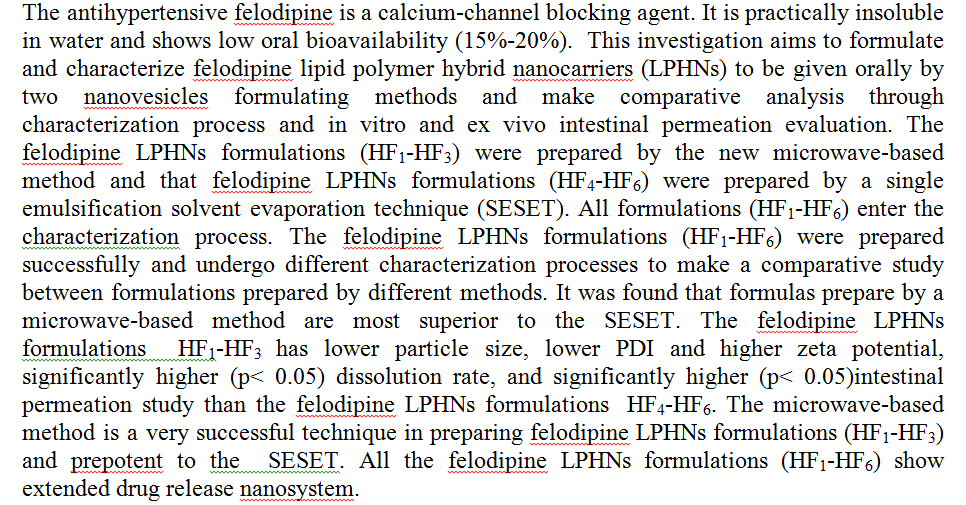Ocular drug delivery is challenging due to the presence of anatomical and physiological barriers. These barriers can affect drug entry into the eye following multiple routes of administration (e.g., topical, systemic, and injectable). Topical administration in the form of eye drops is preferred for treating anterior segment diseases, as it is convenient and provides local delivery of drugs. Major concerns with topical delivery include poor drug absorption and low bioavailability. To improve the bioavailability of topically administered drugs, novel drug delivery systems are being investigated. Nanocarrier delivery systems demonstrate enhanced drug permeation and prolonged drug release. This review provides an overview of ocular barr
... Show More (344)
(344)
 (334)
(334)
Quercetin, one of the flavonoids family member, can be found in many vegetables, fruits, and beverages with a noticeable nutritional pharmacological properties. This study was aimed to evaluate the ability of quercetin to inhibit lipopolysaccharide (LPS) that induced lethal toxicity in vivo, and to elucidate the importance of the quercetin as an antitumor agent in breast cancer cell line MCF-7.In vivo experiments included the effect of hesperidin and LPS on the liver and spleen of male mice. In the liver, the antioxidant activity was measured by estimating the concentration of glutathione (GSH), and catalase (CAT), while in the spleen, the concentration of cytokines was measured including IL-33 and TNF-α. In vitro experiments included MTT
... Show MoreCancer disease has a complicated pathophysiology and is one of the major causes of death and morbidity. Classical cancer therapies include chemotherapy, radiation therapy, and immunotherapy. A typical treatment is chemotherapy, which delivers cytotoxic medications to patients to suppress the uncontrolled growth of cancerous cells. Conventional oral medication has a number of drawbacks, including a lack of selectivity, cytotoxicity, and multi-drug resistance, all of which offer significant obstacles to effective cancer treatment. Multidrug resistance (MDR) remains a major challenge for effective cancer chemotherapeutic interventions. The advent of nanotechnology approach has developed the field of tumor diagnosis and treatment. Cancer nanote
... Show More (9)
(9)
 (6)
(6)
Background: Simvastatin (SIM) is a lipid-lowering agent to prevent disorders caused by clogged blood vessels. Because of its low solubility, it has low bioavailability. The adsorption technique is effective in improving drug solubility and dissolution rate. Objective: To use magnesium aluminum silicate (MAS) as an adsorbent in combination with Soluplus® as a hydrophilic polymer to formulate SIM as immediate-release tablets (IRTs). Methods: We used the solvent evaporation method to make MAS-loaded SIM in the presence of Soluplus®, making sure that the ratio of SIM to MAS to SOLU was 1:6:3. We then used this mixture to make IRTs. Using the direct compression method, we made all of the SIM-IRT formulas. We used diluents like Avicel
... Show MoreDarifenacin hydrobromide is a selective ?3 receptor antimuscarinic drug and it is used in the management of urinary frequency, urgency, and incontinence in detrusor instability. It slightly soluble in water, undergoes extensive hepatic first-pass metabolism and has short elimination half-life (3–4 hours). Therefore, It has low bioavailability (15.4 % - 18.6 %). Darifenacin hydrobromide loaded NLCs were formulated by emulsification sonication using different ratios of solid lipid to liquid lipid, different types of surfactants, and different concentration of surfactants. Formula sixteen was considered as an optimized formula based on its particle size, PDI, zeta potential and entrapment efficiency. Formula sixteen subjected t
... Show More (11)
(11)
 (1)
(1)
 (23)
(23)
 (18)
(18)
(1) Background: Plant flavonoids are efficient in preventing and treating various diseases. This study aimed to evaluate the ability of hesperidin, a flavonoid found in citrus fruits, in inhibiting lipopolysaccharide (LPS) induced inflammation, which induced lethal toxicity in vivo, and to evaluate its importance as an antitumor agent in breast cancer. The in vivo experiments revealed the protective effects of hesperidin against the negative LPS effects on the liver and spleen of male mice. (2) Methods: In the liver, the antioxidant activity was measured by estimating the concentration of glutathione (GSH) and catalase (CAT), whereas in spleen, the concentration of cytokines including IL-33 and TNF-α was measured. The in vitro expe
... Show More (38)
(38)
 (34)
(34)
In this paper, a miniaturized 2 × 2 electro-optic plasmonic Mach– Zehnder switch (MZS) based on metal–polymer–silicon hybrid waveguide is presented. Adiabatic tapers are designed to couple the light between the plasmonic phase shifter, implemented in each of the MZS arms, and the 3-dB input/output directional couplers. For 6 µm-long hybrid plasmonic waveguide supported by JRD1 polymer (r33= 390 pm/V), a π-phase shift voltage of 2 V is obtained. The switch is designed for 1550 nm operation wavelength using COMSOL software and characterizes by 2.3 dB insertion loss, 9.9 fJ/bit power consumption, and 640 GHz operation bandwidth
 (5)
(5)
 (4)
(4)

